Caecitellus
Ultrastructure
Unlike other stramenopiles, the anterior flagellum does not bear
tripartite tubular hairs. Because this feature is absent,
protistologists placed Caecitellus in groups other than
the stramenopiles until the kinetid architecture was
reconstructed. It may be that other protists that lack flagellar
hairs, and whose relationships are presently unknown, are stramenopiles.
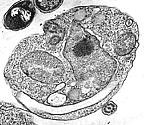 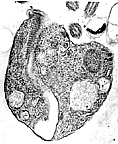 The cells are uninucleate. The two flagellar bases of nondividing
cells are found just anterior to the nucleus. Several
sausage-shaped mitochondria
are present; as in other stramenopiles, the cristae are tubular. The
cytopharynx is permanently differentiated and prominent. No
extrusomes are present on the cell periphery.
The cells are uninucleate. The two flagellar bases of nondividing
cells are found just anterior to the nucleus. Several
sausage-shaped mitochondria
are present; as in other stramenopiles, the cristae are tubular. The
cytopharynx is permanently differentiated and prominent. No
extrusomes are present on the cell periphery. |
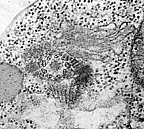 There is a single Golgi
body anterior to the nucleus and near the flagellar bases. There is a single Golgi
body anterior to the nucleus and near the flagellar bases.
|
  The cytoskeleton is
based on an asymmetrical system of two flagellar bases and three microtubular
roots. The arrangement is much like that in the bicosoecids, including
Cafeteria. The cytoskeleton is
based on an asymmetrical system of two flagellar bases and three microtubular
roots. The arrangement is much like that in the bicosoecids, including
Cafeteria. |
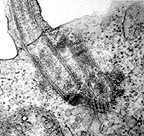 One of the three microtubular roots arises
from the anterior basal body. In most other stramenopiles including
Cafeteria, this
root has secondary cytoskeletal microtubules associated with it, but in
Caecitellus these microtubules have not been found. One of the three microtubular roots arises
from the anterior basal body. In most other stramenopiles including
Cafeteria, this
root has secondary cytoskeletal microtubules associated with it, but in
Caecitellus these microtubules have not been found. |
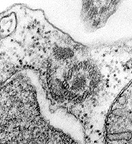  The other two
microtubular roots arise from the posterior basal body. The
compound root R3 arises on the right side of the basal body,
initially with ca. 11 microtubules, and then splits into an
outer ("x", single microtubule), middle (initially 8 microtubules, adding
around 16 more near the cytostome), and inner (three
microtubules) subunits. The outer and middle subunits define
the outer margin of the cytostome, while the inner subunit
defines the margin of the posterior flagellar groove. The R3
root is connected to the two basal bodies by a striated
fiber. The R4 root arises on the left side of the posterior
basal body. It has two microtubules and terminates in the
vicinity of the far end of root R3. The posterior root array
is the same as in Cafeteria and
other bicosoecids. The other two
microtubular roots arise from the posterior basal body. The
compound root R3 arises on the right side of the basal body,
initially with ca. 11 microtubules, and then splits into an
outer ("x", single microtubule), middle (initially 8 microtubules, adding
around 16 more near the cytostome), and inner (three
microtubules) subunits. The outer and middle subunits define
the outer margin of the cytostome, while the inner subunit
defines the margin of the posterior flagellar groove. The R3
root is connected to the two basal bodies by a striated
fiber. The R4 root arises on the left side of the posterior
basal body. It has two microtubules and terminates in the
vicinity of the far end of root R3. The posterior root array
is the same as in Cafeteria and
other bicosoecids. |
Return to summary information

 The cells are uninucleate. The two flagellar bases of nondividing
cells are found just anterior to the nucleus. Several
sausage-shaped mitochondria
are present; as in other stramenopiles, the cristae are tubular. The
cytopharynx is permanently differentiated and prominent. No
extrusomes are present on the cell periphery.
The cells are uninucleate. The two flagellar bases of nondividing
cells are found just anterior to the nucleus. Several
sausage-shaped mitochondria
are present; as in other stramenopiles, the cristae are tubular. The
cytopharynx is permanently differentiated and prominent. No
extrusomes are present on the cell periphery.




